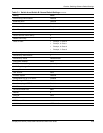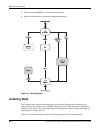
Compaq ProLiant BL p-Class GbE Interconnect Switch User Guide D-1
COMPAQ CONFIDENTIAL Codename: Vanilla Part Number: 263680-001 Last Saved On: 4/23/02 10:15 AM
D
Spanning Tree Protocol
Introduction
When the Spanning Tree Protocol (STP) determines that a port should be transitioned to the
forwarding state, the following occurs:
• The port is put into the listening state where it receives Bridge Protocol Data Units
(BPDUs) and passes them to the processor of the GbE Interconnect Switch.
• If no BPDUs that suggest the port should go to the blocking state are received, the BPDU
packets from the processor are processed.
— The port waits for the expiration of the forward delay timer. The port then moves to
the learning state.
— In the learning state, the port learns station location information from the source
addresses of packets and adds this information to its forwarding database.
— The expiration of the forwarding delay timer moves the port to the forwarding state,
where both learning and forwarding are enabled. At this point, the port forwards
packets.
Blocking State
A port in the blocking state does not forward packets. When the switch is booted, a BPDU is
sent to each port in the switch putting these ports into the blocking state.
A switch initially assumes it is the root switch for a network. When the switch begins to
exchange BPDUs with other switches, the switch that is the best choice for the root switch is
determined. If there is only one switch on the network, no BPDU exchange occurs, the
forward delay timer expires, and the ports move to the listening state. All STP-enabled ports
enter the blocking state following switch boot.
A port in the blocking state:
• Discards packets received from the network segment to which it is attached.
• Discards packets sent from another port on the switch for forwarding.
• Does not add addresses to its forwarding database.
• Receives BPDUs and directs them to the processor.


















